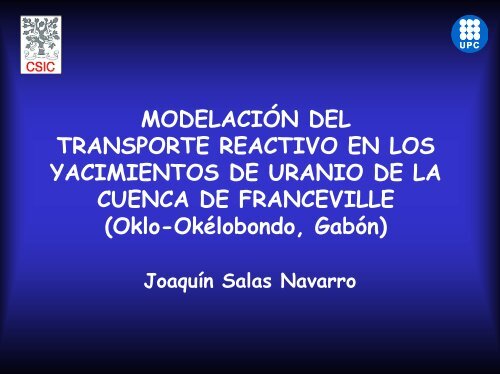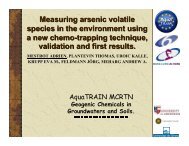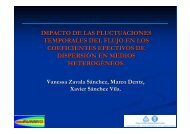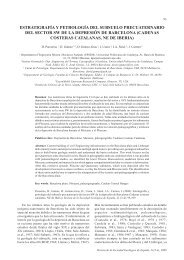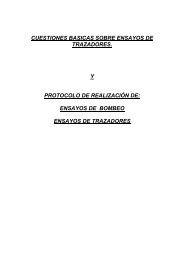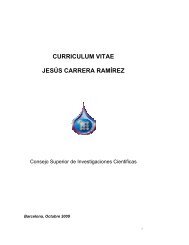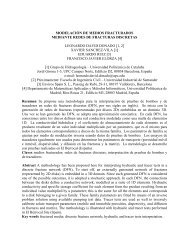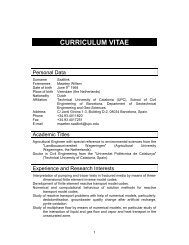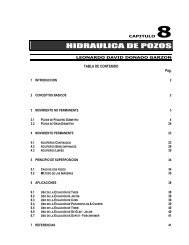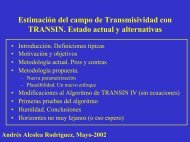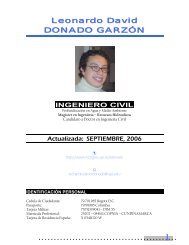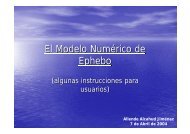Modelación del transporte reactivo en los yacimientos de ... - UPC
Modelación del transporte reactivo en los yacimientos de ... - UPC
Modelación del transporte reactivo en los yacimientos de ... - UPC
Create successful ePaper yourself
Turn your PDF publications into a flip-book with our unique Google optimized e-Paper software.
<strong>UPC</strong><br />
MODELACIÓN DEL<br />
TRANSPORTE REACTIVO EN LOS<br />
YACIMIENTOS DE URANIO DE LA<br />
CUENCA DE FRANCEVILLE<br />
(Oklo-Okélobondo, Gabón)<br />
Joaquín Salas Navarro
¿Qué es Oklo?<br />
Oklo (Gabón) yacimi<strong>en</strong>to U:<br />
*sedim<strong>en</strong>tario<br />
*edad Proterozoico inf.<br />
Gabón<br />
Únicos paleorreactones<br />
nucleares naturales<br />
Ecuador<br />
Port G<strong>en</strong>til<br />
300 km<br />
Libreville<br />
Oklo<br />
Franceville<br />
12º49'E 13º12'E 13º35'E<br />
Lastourville<br />
N<br />
Macizo<br />
<strong>de</strong><br />
Chaillu<br />
10 km<br />
Boyindzi<br />
Mounana<br />
id<strong>en</strong>tificados <strong>en</strong> el Mundo (2·10 9 a)<br />
producto <strong>de</strong>s<strong>en</strong>cad<strong>en</strong>ami<strong>en</strong>to reacciones fisión nuclear<br />
Sedim <strong>en</strong>tos post-FA<br />
Formación FA (> 500 m)<br />
Zócalo arcaico<br />
Diques <strong>de</strong> dolerita<br />
Fallas<br />
OKLO<br />
Ki<strong>en</strong>e<br />
Bangombé<br />
Mikouloungou<br />
Franceville<br />
1º00'<br />
S<br />
1º19'S<br />
1º38'S
¿Qué es Oklo?<br />
15<br />
1<br />
2 6<br />
34 - 5<br />
N<br />
1-2Oklo<br />
3-6<br />
7-9<br />
13<br />
W-E<br />
350 m<br />
7-9<br />
100 m<br />
10,16,OK 84b<br />
13<br />
16<br />
10-11<br />
FB: niveles ar<strong>en</strong>oso-dolomíticos<br />
FB: pelitasnegras<br />
FA, serie C1 y reactores<br />
FA: ar<strong>en</strong>iscasy conglomerados<br />
Zócalo plutónico<br />
50<br />
300<br />
300 m<br />
100<br />
OK 84b<br />
Ar<strong>en</strong>isca mineralizada<br />
Diquedolerita<br />
Reactor aflorante<br />
Reactor subterráneo<br />
Talud<br />
Derrubios<br />
100<br />
ProfundidadFA-FB<br />
16 paleorreactores<br />
*a cielo abierto (explotados excepto reactor 2)<br />
*galerías <strong>de</strong> prospección
Motivación y objetivos <strong>de</strong> la tesis<br />
Conservación y preservación <strong>de</strong> productos fisiogénicos<br />
Amb. hidrogeológico favorable: estanqueidad <strong>de</strong>pósito<br />
Paleorreactores: análogos naturales<br />
*Objetivos:<br />
1) Mecanismos hidrogeológicos movilización U<br />
(a) formación <strong><strong>de</strong>l</strong> yacimi<strong>en</strong>to<br />
(b) alteración actual paleorreactor <strong>de</strong> Okélobondo<br />
2) Comprobar funcionami<strong>en</strong>to instrum<strong>en</strong>tos simulación numérica
Cont<strong>en</strong>ido<br />
1º Contexto geológico. Hipótesis bibliografía<br />
2º Mo<strong><strong>de</strong>l</strong>ación paleoflujo 2D<br />
-<strong>de</strong>scartar hipótesis<br />
3º Mo<strong><strong>de</strong>l</strong>ación paleoflujo 3D<br />
-esc<strong>en</strong>arios hidrogeológicos<br />
4º Mo<strong><strong>de</strong>l</strong>ación <strong>transporte</strong> <strong>reactivo</strong><br />
-mecanismos geoquímicos y observaciones<br />
5º Oxidación paleorreactor Okélobondo<br />
- mo<strong><strong>de</strong>l</strong>ación <strong>transporte</strong> <strong>reactivo</strong> y validación
Contexto geológico <strong>de</strong> <strong>los</strong> yacimi<strong>en</strong>tos<br />
<strong>de</strong> uranio <strong>de</strong> la cu<strong>en</strong>ca <strong>de</strong> Franceville
FE<br />
FD<br />
FC<br />
Zona móvil <strong>de</strong> Ogooué<br />
50 km<br />
Booué<br />
Plateau <strong>de</strong>s<br />
Abeilles<br />
Macizo <strong>de</strong><br />
Chaillu<br />
Estratigrafía y estructura<br />
Lastourville<br />
Oklo<br />
Serie Francevili<strong>en</strong>se<br />
Cu<strong>en</strong>cas hundimi<strong>en</strong>to FA-FB<br />
Okondja<br />
Franceville<br />
N<br />
Cu<strong>en</strong>ca <strong>de</strong><br />
Okondja<br />
Cu<strong>en</strong>cas <strong>de</strong> Franceville<br />
-Lastoursville<br />
100 m<br />
W-E<br />
FB 2<br />
FB 1<br />
FB: pelitas negras<br />
Mineralización-reactores<br />
FA<br />
Zócalo plutónico<br />
FA<br />
Arcaico<br />
U<br />
Dolomías<br />
Pelitas reductoras<br />
Ar<strong>en</strong>iscas<br />
5 km<br />
Oklo<br />
Zócalo<br />
Mounana<br />
Magna
Mineralización<br />
*Ar<strong>en</strong>isca mineralizada típica (2.41·10 4 tm):<br />
0.1-1% U<br />
silificada y hematítica<br />
matriz: illita, clorita y sulfuros<br />
*Oklo (1.73·10 4 tm):<br />
15% U: hidrofracturación<br />
mat. org., calcita, sulfuros y uraninita<br />
600 micras<br />
FA<br />
FB<br />
1m<br />
*Paleorreactores:<br />
20-80% U<br />
ganga arcil<strong>los</strong>a <strong>de</strong>silificada<br />
trazas el. fisiogén. y min. accesorios
I<strong>de</strong>as previas. Hipótesis (1)<br />
Bibliografía<br />
W-E<br />
a) No acuerdo:<br />
-datación relativa<br />
-mecanismos advectivos<br />
-fu<strong>en</strong>te primaria U<br />
1 km<br />
?<br />
b) Acuerdo mo<strong><strong>de</strong>l</strong>o geoquímico conceptual:<br />
-solución oxidante transporta U(VI)<br />
-interacción medio reductor: U(VI)= U(IV)
I<strong>de</strong>as previas. Hipótesis (2)<br />
Mineralización <strong>en</strong>:<br />
1) ar<strong>en</strong>isca mineralizada silificada y fracturada<br />
2) pres<strong>en</strong>cia hidrocarburos<br />
3) fr<strong>en</strong>tes redox no mineralizados<br />
Indica ev<strong>en</strong>to posterior a:<br />
1) Fase diag<strong>en</strong>ética silícica y etapa tectónica<br />
2) Maduración mat. orgánica<br />
3) Oxig<strong>en</strong>ación atmosférica
I<strong>de</strong>as previas. Hipótesis (3)<br />
Fu<strong>en</strong>te <strong><strong>de</strong>l</strong> U<br />
a) uranotoritas FA <strong>de</strong>scartadas<br />
b) mat. volcánico series superiores (poco probable)<br />
c) zócalo plutónico (se evaluará)<br />
d) <strong>de</strong>p. uraninita <strong>de</strong>trítica<br />
Balance <strong>de</strong> masas: sist. convectivo<br />
Solubilidad uraninita: [U] max =10 -6 -10 -7 mol·L -1<br />
Otros <strong>de</strong>p. uraníferos: t min = 10 5 a<br />
|q| v min. zona yacimi<strong>en</strong>to:<br />
4·10 -7 m3·m-2·s-1
Recapitulación: historia geológica<br />
Tiempo<br />
(·10 9 a) B.P.<br />
2.30-2.00 Sedim<strong>en</strong>tación Francevili<strong>en</strong>se<br />
2.20-2.10 Oxig<strong>en</strong>ación atmosférico ?<br />
2.10 Diagénesis silícica<br />
2.05 Máximo hundimi<strong>en</strong>to cu<strong>en</strong>ca<br />
Fase tectónica 1. D<strong>en</strong>udación<br />
Formación <strong><strong>de</strong>l</strong> yacimi<strong>en</strong>to<br />
1.97-1.95 Reacciones fisión<br />
Actualidad<br />
Explotación y oxidación <strong>de</strong> la mineralización
Mo<strong><strong>de</strong>l</strong>ación 2D <strong><strong>de</strong>l</strong> paleoflujo regional
Objetivos<br />
1.-Analizar hipótesis<br />
(mo<strong><strong>de</strong>l</strong>o <strong>de</strong> flujo compatible y cuantit. sufici<strong>en</strong>te)<br />
2.-Comparar flujo difer<strong>en</strong>tes sistemas advectivos<br />
a) convección térmica natural (CODE_BRIGHT)<br />
b) consolidación sedim<strong>en</strong>tos (BASIN)<br />
c) conv. forzado gradi<strong>en</strong>te topográfico (CODE_BRIGHT)
Convec. térm. natural: mo<strong><strong>de</strong>l</strong>o conceptual<br />
WSW-ENE<br />
Reg. sedim<strong>en</strong>tación marina<br />
Máximo hundimi<strong>en</strong>to cu<strong>en</strong>ca<br />
4000 m<br />
5 km<br />
FB<br />
FA<br />
Falla<br />
Yacimi<strong>en</strong>to<br />
Gradi<strong>en</strong>te geotérmico:<br />
0.04ºC·m -1<br />
FB-pelitas<br />
Hidrocarburos<br />
Mineralización <strong>de</strong> uranio<br />
FA: ar<strong>en</strong>iscas y pelitas<br />
FA: conglomerados basales<br />
Dep. <strong>de</strong>tríticos<br />
uraninita basales<br />
3<br />
2<br />
FB 4<br />
FA<br />
WSW-ENE<br />
1 6<br />
1000 m<br />
5<br />
Parámetros hidrológicos:<br />
a) bibliografía cu<strong>en</strong>cas profundas<br />
b) aflorami<strong>en</strong>tos litologías francevili<strong>en</strong>ses
Convección térmica natural: resultados<br />
Profundidad (m)<br />
Profundidad (m)<br />
20<br />
40<br />
0<br />
2000<br />
4000<br />
0<br />
2000<br />
4000<br />
60<br />
WSW-ENE<br />
Ra=41<br />
0 2 4 6 8 10 12 14 16 18 20<br />
0 2 4 6 8 10 12 14 16 18 20<br />
80<br />
100<br />
T (ºC)<br />
120<br />
140<br />
160<br />
180<br />
Distancia (km)<br />
Ra=72<br />
|q| (m 3 ·m -2 ·s -1 )<br />
|q| (m 3 ·m -2 ·s -1 ) FA-FB<br />
1E-7<br />
1E-8<br />
1E-9<br />
1E-10<br />
1E-11<br />
6E-9<br />
5E-9<br />
4E-9<br />
3E-9<br />
2E-9<br />
1E-9<br />
10<br />
40<br />
(+) (-) (+) (-) (+)<br />
Ra=41<br />
Ra<br />
Ra=72<br />
Máximo FA<br />
Promedio FA<br />
1 1'<br />
Promedio series superiores<br />
50 60 70 80<br />
Ra=60<br />
Ra=50<br />
12 14 16 18 20<br />
Distancia (km)<br />
Flujo claram<strong>en</strong>te insufici<strong>en</strong>te (muy elevadas K para FA y FB)
Convec. térmica natural: resultados fallas<br />
3-4·10 -8 m 3·m -2·s -1 con cierta in<strong>de</strong>p<strong>en</strong>d<strong>en</strong>cia K fm basales<br />
1E-7<br />
Máximo falla<br />
WSW-ENE<br />
Profundidad (m)<br />
0<br />
1000<br />
2000<br />
3000<br />
4000<br />
|q| (m 3·m -2·s -1 )<br />
1E-7<br />
1E-8<br />
1E-9<br />
1E-10<br />
FB2 1E-11<br />
FB1<br />
FA<br />
FA-FB interfase<br />
Ra=23<br />
|q| (m 3·m -2·s -1 )<br />
1E-8<br />
1E-9<br />
1E-10<br />
1E-11<br />
20<br />
Promedio series superiores<br />
Promedio FA sist. con falla<br />
30 40<br />
50<br />
Ra<br />
60 70 80<br />
0 2 4 6 8 10 12 14 16 18 20<br />
Distancia (km)<br />
20<br />
40<br />
60<br />
80<br />
100<br />
120<br />
140<br />
160<br />
180<br />
T (ºC)<br />
Máximo flujo obt<strong>en</strong>ido 1 ord<strong>en</strong> magnitud inferior Oklo
Convección forzada gradi<strong>en</strong>te topográfico (1)<br />
Macizo <strong>de</strong><br />
Chaillu<br />
WSW-ENE<br />
C. <strong>de</strong> Franceville<br />
Lastoursville<br />
Mole <strong>de</strong><br />
Ondili-Dambi<br />
Cu<strong>en</strong>ca <strong>de</strong> Okondja<br />
Macizo <strong><strong>de</strong>l</strong><br />
N Gabón<br />
20 km<br />
Depósitos volcánicos submarinos<br />
Fm. sedim<strong>en</strong>taria post FA<br />
Fm. FA<br />
Zócalo plutónico<br />
Convección serie sedim<strong>en</strong>taria<br />
Topografía variable<br />
Cota (m)<br />
0<br />
-2000<br />
-4000<br />
-6000<br />
FC-FD-FE<br />
FB<br />
FA<br />
Zócalo plutónico<br />
Convección zócalo plutónico<br />
Topografía variable, papel fallas<br />
Cota (m)<br />
2000<br />
0<br />
-2000<br />
-4000<br />
-6000<br />
Zócalo plutónico<br />
Macizo <strong>de</strong> Chaillu<br />
FE<br />
FD<br />
FB<br />
FA<br />
0 10 20 30 40 50 60 70 80 90<br />
Distancia (km)<br />
-8000<br />
Yacimi<strong>en</strong>to<br />
Fallas<br />
0 10 20 30 4 0 50<br />
Distancia (km)
Convección forzada gradi<strong>en</strong>te topográfico (2)<br />
-Orig<strong>en</strong> U: <strong>de</strong>p. basales FA<br />
Profundidad (m)<br />
-2000<br />
-4000<br />
-6000<br />
+1200 m<br />
+550 m<br />
0<br />
WSW-ENE<br />
+1200 m<br />
0 20 40 60 80<br />
Distancia (km)<br />
-Flujo sufici<strong>en</strong>te zona yacimi<strong>en</strong>to:<br />
a) grad. topográfico hacia el E<br />
b)> 0.1095 m·m -1<br />
+2700 m<br />
25<br />
75<br />
100<br />
120<br />
140<br />
160<br />
180<br />
200<br />
220<br />
240<br />
260<br />
280<br />
300<br />
320<br />
T (ºC)<br />
Profundidad (m)<br />
0<br />
-1000<br />
-2000<br />
-3000<br />
-4000<br />
-5000<br />
-6000<br />
FE<br />
FC-FD<br />
FB 2<br />
FB 1<br />
FA<br />
zócalo<br />
1E-10<br />
1E-8<br />
1E-11 1E-9 1E-7<br />
|q| (m 3·m-2·s-1 )<br />
*No grad. topog. hacia E<br />
infiltración a través FD y FB 1 !!!!!!
Convección forzada gradi<strong>en</strong>te topográfico (3)<br />
4000<br />
2000<br />
WSW-ENE<br />
25<br />
50<br />
Cota (m)<br />
0<br />
-2000<br />
100<br />
150<br />
200<br />
250<br />
T (ºC)<br />
Flujo zócalo insufici<strong>en</strong>te<br />
(10 -9 m 3·m -2·s -1 )<br />
-4000<br />
-6000<br />
300<br />
350<br />
400<br />
Poca s<strong>en</strong>sibilidad grad. topog.<br />
Descarga límite fm superiores<br />
450<br />
-8000<br />
0 5 10 15 20 25 30 35<br />
Distancia (km)<br />
1E-7<br />
500<br />
Flujo fallas sufici<strong>en</strong>te<br />
(10 -7 m 3·m -2·s -1 )<br />
Incompatibilidad geoquímica<br />
|q| (m 3·m -2·s -1 )<br />
1E-8<br />
1E-9<br />
1E-10<br />
1E-11<br />
-2200<br />
Cota (m)<br />
-3300<br />
-5600<br />
0 5 10<br />
15 20 25 30 35<br />
Distancia (km)
Flujo por consolidación<br />
BASIN (Bitzer, 1996,1997)<br />
5.0 km<br />
q v yacimi<strong>en</strong>to=3·10 -10 m3·m-2·s-1<br />
3 órd<strong>en</strong>es mag. inferior q Oklo<br />
<strong>de</strong>spreciable fr<strong>en</strong>te conv. grad. topog.<br />
Hundimi<strong>en</strong>to cu<strong>en</strong>ca:<br />
invasión fluidos reductores FB hacia techo FA<br />
(creación fr<strong>en</strong>tes redox sin anomalías uraníferas)
Conclusiones (1)<br />
1.- Flujo conv. termica natural<br />
grad. topog. zócalo<br />
consolidación sedim<strong>en</strong>tos<br />
2.- Flujo conv. Grad. topográfico<br />
litologías sedim<strong>en</strong>tarias<br />
Insufici<strong>en</strong>tes<br />
(10 5 años)<br />
Incompatible<br />
paleogeografía<br />
geoquímica<br />
3.- Fallas conc<strong>en</strong>tradoras <strong><strong>de</strong>l</strong> flujo local
Conclusiones (2)<br />
12º49'E 13º12'E 13º35'E<br />
Lastoursville<br />
N<br />
Macizo<br />
<strong>de</strong><br />
Chaillu<br />
25 km<br />
Oklo<br />
post-FA<br />
FA (>500 m)<br />
Franceville<br />
1º00'S<br />
1º19'S<br />
1º38'S<br />
Evid<strong>en</strong>cias:<br />
a) oxidación base FA Lastoursville<br />
b) fr<strong>en</strong>tes redox Oklo<br />
c) ar<strong>en</strong>isca reducida Franceville<br />
Flujo regional NW-SE!!!<br />
Estr. geológicas distribución flujo<br />
Análisis 3D
Mo<strong><strong>de</strong>l</strong>ación 3D <strong><strong>de</strong>l</strong> paleoflujo regional
Objetivos<br />
1.-Construir mo<strong><strong>de</strong>l</strong>o numérico acuífero basal<br />
2.-Id<strong>en</strong>tificar esc<strong>en</strong>arios hidrogeológicos<br />
3.-Estudiar influ<strong>en</strong>cia estructuras geológicas<br />
(sedim<strong>en</strong>tológicas, estratigráficas y tectónicas)
2000 m<br />
Falla Yeye-Kaya-Kaya<br />
N<br />
Pelitas FB<br />
Ar<strong>en</strong>iscas FA<br />
Granitoi<strong>de</strong>s<br />
NW-SE<br />
10 km<br />
CUENCA FRANCEVILLE<br />
Léyou-Mounana<br />
CUENCA DE<br />
LASTOURSVILLE<br />
Falla <strong>de</strong><br />
20 km<br />
2000 m<br />
Ondili<br />
CUENCA<br />
FRANCEVILLE<br />
10 km<br />
SW-NE<br />
Introducción<br />
CUENCA<br />
LASTOURSVILLE<br />
Umbral Lastoursvi<br />
lle<br />
PLATEAU DES<br />
ABEILLES<br />
Nord Léyou<br />
Mounana<br />
N<br />
FC: jaspes y dolomías<br />
FB: pelitas y <strong>de</strong>p. turbidíticos<br />
FA: conglomerados, ar<strong>en</strong>iscas y limos<br />
Zócalo plutónico<br />
Falla <strong>de</strong> Léyou-Mounana<br />
N<br />
Oklo<br />
FB<br />
FA<br />
F. Léyou-Mounana<br />
Cu<strong>en</strong>cas<br />
sedim<strong>en</strong>tarias<br />
Zócalo plutónico<br />
FC, FD y FE<br />
Macizo <strong>de</strong><br />
Chaillu<br />
10 km<br />
2000 m
Mo<strong><strong>de</strong>l</strong>o numérico<br />
SW-NE<br />
9512 nudos<br />
8176 elem. hexaédricos ocho nodos<br />
NW-SE<br />
10 km<br />
Gradi<strong>en</strong>tes topográficos:<br />
FD-FE<br />
FE<br />
FB<br />
FA<br />
SW-NE<br />
Cu<strong>en</strong>ca <strong>de</strong> Franceville Cu<strong>en</strong>ca <strong>de</strong> Lastoursville<br />
SE-NW<br />
10 km<br />
5 km<br />
Falla <strong>de</strong> Léyou-Mounana<br />
Macizo Chaillu: 0.083 m·m -1 C. Lastoursville: 0.019 m·m -1<br />
Fallas hidráulicam<strong>en</strong>te no conductivas
Resultados<br />
x (km)<br />
0 5 10 15 20 25<br />
Zócalo Ondili<br />
FA-FB1 Franceville<br />
30<br />
25<br />
20<br />
15<br />
10<br />
5<br />
0<br />
c*<br />
Base FA<br />
Lastoursville<br />
(z=1500-2000 m)<br />
|q| (m 3·m -2·s -1 )<br />
y (km)<br />
1.0E-8<br />
2.0E-8<br />
3.0E-8<br />
4.0E-8<br />
5.0E-8<br />
7.5E-8<br />
1.0E-7<br />
5.0E-7<br />
Zócalo Chaillu<br />
SE-NW<br />
5 km<br />
(·10 -9 ) |q| (m 3·m -2·s -1 )<br />
50<br />
25<br />
10<br />
5<br />
0<br />
SW-NE<br />
750 m<br />
SE-NW
Conclusión<br />
N<br />
OKLO<br />
5 Km<br />
FRANCEVILLE<br />
LASTOURSVILLE<br />
Falla L-M<br />
Flujo vert.: 5·10 -7 m3·m-2·s-1<br />
(sin fallas cond. y grad. topog. m<strong>en</strong>ores)<br />
sufici<strong>en</strong>te para formar Oklo:<br />
t=10 5 a<br />
[U]=10 -6 -10 -7 mol·L -1
Mo<strong><strong>de</strong>l</strong>ación <strong><strong>de</strong>l</strong> <strong>transporte</strong> <strong>reactivo</strong><br />
durante la formación <strong><strong>de</strong>l</strong> yacimi<strong>en</strong>to
Objetivos<br />
1.-Caracterizar geoquímicam<strong>en</strong>te el acuífero (distribución U)<br />
2.-Verificar posibilidad <strong>transporte</strong> U, a nivel <strong>de</strong> cu<strong>en</strong>ca,<br />
condiciones hidrogeológicas profundas<br />
SE-NW<br />
z (m)<br />
4000<br />
(c)<br />
(a)<br />
(b)<br />
x= 8050 m<br />
5 10 15 20 25 30<br />
y (m)<br />
(·10 -9 ) |q| (m 3·m-2·s-1 )<br />
2000<br />
0<br />
Integración datos geoquímicos:<br />
inclusiones fluidas<br />
paragénesis minerales<br />
cu<strong>en</strong>cas profundas actuales<br />
0 5 10 25 50 75 100 200 300 500 800
Metodología y mo<strong><strong>de</strong>l</strong>o conceptual (1)<br />
539 nudos<br />
538 elem<strong>en</strong>tos lineales<br />
∆x (m)<br />
LASTOURSVILLE<br />
FRANCEVILLE<br />
∆x<br />
M4<br />
x=0 km<br />
5<br />
10<br />
25<br />
50<br />
100<br />
200<br />
x=19 km<br />
x=21 km<br />
x=23 km<br />
x=26 km<br />
x=28 km<br />
x=35 km<br />
Mat.<br />
M1<br />
M3<br />
M1 M2 M2<br />
Casos 2 y 3<br />
ºC<br />
190<br />
100<br />
Caso 1<br />
Temperaturas<br />
150<br />
135<br />
Caso 4
Metodología y mo<strong><strong>de</strong>l</strong>o conceptual (2)<br />
Aguas contorno<br />
Log fO 2 (g)<br />
14 especies primarias<br />
40 complejos acuosos<br />
16 minerales<br />
10<br />
0<br />
-10<br />
-20<br />
-30<br />
-40<br />
-50<br />
T=135ºC<br />
FeCl 2<br />
+<br />
USO 4<br />
2+<br />
UO 2<br />
2+<br />
uraninita<br />
UO 2 OH +<br />
Fe 2+<br />
Caolinita<br />
UO 2 (CO 3 ) 2<br />
2-<br />
calcita<br />
Moscovita<br />
Hematites<br />
Si<strong>de</strong>rita<br />
K-fel<strong>de</strong>spato<br />
UO 2 (CO 3 ) 3<br />
4-<br />
-60<br />
2 3 4 5 6 7<br />
pH
Resultados (1)<br />
T (ºC)<br />
190<br />
150<br />
135<br />
100<br />
2·10 -7<br />
-1<br />
m3·m-2·s Ar<strong>en</strong>isca<br />
Disol. (-) / Precipit. (+)<br />
(mol·m -3 roca)<br />
7E-4<br />
5E-4<br />
3E-4<br />
hematítica FA<br />
Dep. uraníticos <strong>de</strong>tríticos<br />
Lastoursville - Franceville<br />
35 km<br />
5E-5<br />
0E+0<br />
-5E-5<br />
Km 20 Km 25<br />
1E-4<br />
-1E-4<br />
-1E-4 Hematites<br />
Uraninita<br />
-2E-4<br />
0 5 10 15 20 25 30 35 0 5 10 15 20 25 30 35<br />
Distancia (km)<br />
Distancia (km)<br />
1) Precipitación inicial hematites (eq. Fe 2+ -Fe 2 O 3 (s))<br />
disolución dolomita: pH=4.5-5.0<br />
Conc<strong>en</strong>tr. tot (mol·L -1 )<br />
Log fO 2 (g)<br />
1E-2<br />
1E-3<br />
1E-4<br />
1E-5<br />
1E-6<br />
Fe<br />
1E-7<br />
1E-8<br />
U<br />
1E-9<br />
1E-10<br />
0 5 10 15 20 25 30 35<br />
-22<br />
-24<br />
-26<br />
-28<br />
-30<br />
-32<br />
-34<br />
-36<br />
t=5·10 3 años<br />
Distancia (km)<br />
0 5 10 15 20 25 30 35<br />
Distancia (km)<br />
2) Disolución uraninita (eq. UO 2 (CO 3 ) 2<br />
2-<br />
-UO 2 (s)) [U]=2·10 -7 mol·L -1<br />
bajada redox disolución hematites (eq. Fe 2+ -Fe 2 O 3 (s)) [Fe]=4·10 -7 mol·L -1
Resultados (2)<br />
T (ºC)<br />
2·10 -7<br />
190<br />
150<br />
135<br />
100<br />
Lastoursville - Franceville<br />
35 km<br />
m 3·m -2·s -1 Km 20 Km 25 Km 28<br />
Ar<strong>en</strong>isca hematítica FA<br />
Depósitos uraníticos <strong>de</strong>tríticos<br />
Litologías ricas <strong>en</strong> materia orgánica<br />
Disol. (-) / Precipit. (+)<br />
(mol·m -3 roca)<br />
0.0E+0<br />
-5.0E-3<br />
-1.0E-2<br />
-1.5E-2<br />
Materia orgánica<br />
6E-4<br />
4E-4<br />
2E-4<br />
0E+0<br />
Uraninita<br />
-2.0E-2<br />
-2E-4<br />
0 5 10 15 20 25 30 35 0 5 10 15 20 25 30 35<br />
Conc<strong>en</strong>tr. tot. (mol·L -1 )<br />
Log fO 2 (g)<br />
1E-2<br />
1E-3<br />
1E-4<br />
Fe<br />
1E-5<br />
1E-6<br />
1E-7<br />
1E-8<br />
1E-9<br />
U<br />
1E-10<br />
0 5 10 15 20 25 30 35<br />
Distancia (km)<br />
-20<br />
-24<br />
-28<br />
-32<br />
-36<br />
-40<br />
-44<br />
-48<br />
-52<br />
0 5 10 15 20 25 30 35<br />
Distancia (km)<br />
Disol. (-) / Precipit. (+)<br />
(mol·m -3 roca)<br />
6E-6<br />
5E-6<br />
4E-6<br />
3E-6<br />
2E-6<br />
1E-6<br />
Pirita<br />
0E-0<br />
-1E-6<br />
0 5 10 15 20 25 30 35<br />
Distancia (km)<br />
0.01<br />
0.00<br />
-0.01<br />
-0.02<br />
-0.03<br />
Hematites<br />
-0.04<br />
0 5 10 15 20 25 30 35<br />
Distancia (km)<br />
Disol. (-) / Precipit. (+)<br />
(mol·m -3 roca)<br />
9E-3<br />
7E-3<br />
5E-3<br />
3E-3<br />
1E-3<br />
Calcita<br />
-1E-3<br />
0 5 10 15 20 25<br />
Distancia (km)<br />
30 35
Conclusiones (1)<br />
1.- Lixiviación litologías marg<strong>en</strong> W cu<strong>en</strong>cas Lastoursville-Franceville<br />
[U] max ~ 5·10 -7 mol·L -1<br />
+<br />
q ~ 2·10 -7 m3·m-2·s-1<br />
+<br />
T ~ 10 5 años<br />
yacimi<strong>en</strong>to Oklo<br />
2.- Lixiviación litologías c<strong>en</strong>tro <strong>de</strong> cu<strong>en</strong>ca<br />
[U] max < 10 -7 mol·L -1<br />
+<br />
<strong>de</strong>p.<br />
q < 2·10 -7 m3·m-2·s-1<br />
Bangombé, Mikouloungou, Kiéné
Conclusiones (2)<br />
3.- Reproducción observaciones:<br />
a) Aus<strong>en</strong>cia <strong>de</strong>pósitos U: cu<strong>en</strong>ca Lastoursville<br />
base FA cu<strong>en</strong>ca Franceville<br />
fm. superiores francevili<strong>en</strong>se<br />
b) Aus<strong>en</strong>cia acumulaciones hematíticas c. Franceville<br />
(ni FA ni fm. superiores)<br />
c) Pres<strong>en</strong>cia impregnaciones uraníferas ar<strong>en</strong>isca basal FA<br />
(c. Franceville)
Mecanismos <strong>de</strong> oxidación actual<br />
<strong><strong>de</strong>l</strong> paleorreactor <strong>de</strong> Okélobondo
Introducción (1)<br />
Reactor OK84b: condiciones <strong>de</strong> repositorio<br />
350 m <strong>de</strong> profundidad<br />
bajo litologías reductoras<br />
W-E<br />
350 m<br />
OK84b<br />
200 m
Introducción (2)<br />
NW-SE<br />
Observación:<br />
Agua capaz disolver UO 2 (s)<br />
profundida<strong>de</strong>s <strong>de</strong> repositorio<br />
[U] (mol·L -1 )<br />
8.3e-9<br />
4.0e-10<br />
6.6e-9<br />
1.1e-8<br />
6.3e-9<br />
2.0e-9<br />
5.7e-9<br />
2.0e-8<br />
1.2e-8<br />
4.2e-7 1.3e-6<br />
1.8e-7<br />
400<br />
300<br />
200<br />
100<br />
0m<br />
1) Agua tipo I: zona NW y superior<br />
reductora y neutra-básica (sat. uraninita)<br />
NW-SE<br />
2) Agua tipo II: zona profunda<br />
oxidante y básica (subs. uraninita)<br />
0.46<br />
4.6<br />
0.04<br />
7.3<br />
0.09<br />
6.7<br />
400<br />
300<br />
0.27 Eh<br />
7.5 pH<br />
0.28<br />
6.1<br />
0.24 0.34<br />
6.6 7.7<br />
0.32<br />
8.3<br />
0.05<br />
7.2 0.29<br />
0.32 8.6<br />
8.1 0.31<br />
0.44 8.0<br />
7.6<br />
200<br />
100<br />
0m
Introducción (3)<br />
Eh (volts)<br />
1.25<br />
1.00<br />
0.75<br />
0.50<br />
0.25<br />
0.00<br />
-0.25<br />
-0.50<br />
-0.75<br />
T=25ºC<br />
Fe(OH) (am)<br />
Tipo I<br />
Tipo II<br />
Fe<br />
2+<br />
3<br />
Mn<br />
[U (tot)]=1.0e-8 mol·L<br />
[Fe (tot)]=1.0e-4 mol·L-1<br />
[Mn (tot)]=1.0e-5 mol·L<br />
Alk=1.0e-3 mol·L-1<br />
2+<br />
MnO (s)<br />
FeCO (s)<br />
MnOOH (s)<br />
MnCO (s)<br />
Fe(OH) (s)<br />
3 4 5 6 7 8 9 10<br />
pH<br />
2<br />
3<br />
3<br />
-1<br />
2<br />
-1<br />
Conc<strong>en</strong>tración Mn (mol·L )<br />
-1<br />
1E-4<br />
1E-5<br />
1E-6<br />
1E-7<br />
Límite <strong>de</strong>tección Fe<br />
Límite <strong>de</strong>tección Mn<br />
1E-7 1E-6 1E-5 1E-4<br />
-1<br />
Conc<strong>en</strong>tración Fe (mol·L )<br />
Tipo I<br />
Tipo II<br />
Problema:<br />
¿Pue<strong>de</strong> ser un hecho común <strong>en</strong> la corteza terrestre?
Objetivos<br />
1.- Construir mo<strong><strong>de</strong>l</strong>os <strong>transporte</strong> <strong>reactivo</strong>:<br />
a) Interpretar quimismo aguas<br />
(pres<strong>en</strong>cia ambi<strong>en</strong>te oxidante <strong>en</strong> profundidad)<br />
b) Reproducir distribución aguas acuífero<br />
2.- Validación resultados muestras analíticas (CIEMAT)<br />
limitaciones mo<strong><strong>de</strong>l</strong>o
Mo<strong><strong>de</strong>l</strong>o conceptual (1)<br />
G.H. l’École <strong>de</strong>s Mines <strong>de</strong> Paris<br />
Mo<strong><strong>de</strong>l</strong>o hidrológico<br />
Permeabilida<strong>de</strong>s<br />
Tiempo resid<strong>en</strong>cia: 1.5-2·10 5 a<br />
(m)<br />
400<br />
Río<br />
Mitembé<br />
WSW-ENE<br />
Plateau <strong>de</strong> Massango<br />
0<br />
-100<br />
Depósito Mn<br />
Pelitas FB<br />
Comp. dolomíticos<br />
Ar<strong>en</strong>isca FA<br />
250 m<br />
Falla zócalo<br />
Paleorreactor
Mo<strong><strong>de</strong>l</strong>o conceptual (2)<br />
Cota (m)<br />
400<br />
200<br />
0<br />
-200<br />
269 nudos<br />
489 elem<strong>en</strong>tos triangulares<br />
Plateau <strong>de</strong><br />
WSW-ENE<br />
Massango<br />
0 200 400 600 800 1000<br />
Distacia (m)<br />
Cota (m)<br />
400<br />
300<br />
200<br />
100<br />
0<br />
-100<br />
WSW-ENE<br />
Plateau <strong>de</strong><br />
Nivel piezométrico Massango (m)<br />
100 300 500 700 900<br />
450.0<br />
442.5<br />
435.0<br />
427.5<br />
420.0<br />
412.5<br />
405.0<br />
397.5<br />
390.0<br />
382.5<br />
375.0<br />
367.5<br />
360.0<br />
Nivel piezométrico (m)<br />
Distancia (m)<br />
13 especies primarias<br />
26 complejos acuosos<br />
17 minerales<br />
agua <strong>de</strong> contorno basada <strong>en</strong> muestras analíticas
Resultados<br />
Disolución (-) / Precipitación (+)<br />
Profundidad (m) Profundidad (m)<br />
400<br />
WSW-ENE<br />
300<br />
200<br />
100<br />
0<br />
-100<br />
Rodocrosita<br />
100 200 300 400 500 600 700 800 900 1000<br />
400<br />
300<br />
200<br />
100<br />
0<br />
-100<br />
100 200 300 400 500 600 700 800 900 1000<br />
Distancia (m)<br />
Dolomita<br />
0.0<br />
-0.4<br />
-0.8<br />
-1.2<br />
-1.6<br />
-2.2<br />
0.0<br />
-0.1<br />
-0.3<br />
-1.0<br />
-2.0<br />
-3.0<br />
mol·m- 3 roca<br />
mol·m- 3 roca<br />
t=2·10 5 años<br />
Profundidad (m) Profundidad (m)<br />
400<br />
300<br />
200<br />
100<br />
0<br />
-100<br />
400<br />
300<br />
200<br />
100<br />
0<br />
-100<br />
WSW-ENE<br />
Clorita<br />
100 200 300 400 500 600 700 800 900 1000<br />
Fe(OH) 3<br />
(am)<br />
0E+0<br />
-2E-4<br />
-4E-4<br />
-5E-4<br />
-6E-4<br />
-7E-4<br />
-8E-4<br />
-9E-4<br />
-1E-3<br />
100 200 300 400 500 600 700 800 900 1000 0.0E+0<br />
Distancia (m)<br />
1.4E-3<br />
1.2E-3<br />
1.0E-3<br />
8.0E-4<br />
6.0E-4<br />
4.0E-4<br />
2.0E-4<br />
mol·m- 3 roca<br />
mol·m- 3 roca<br />
Profundidad (m)<br />
400<br />
300<br />
200<br />
100<br />
0<br />
-100<br />
WSW-ENE<br />
Mn<br />
100 200 300 400 500 600 700 800 900 1000<br />
Distancia (m)<br />
4E-5<br />
2E-5<br />
1E-5<br />
8E-6<br />
6E-6<br />
4E-6<br />
2E-6<br />
1E-6<br />
5E-7<br />
1E-7<br />
0E+0<br />
mol·L- 1<br />
Profundidad (m)<br />
400<br />
300<br />
200<br />
100<br />
0<br />
-100<br />
WSW-ENE<br />
Fe<br />
100 200 300 400 500 600 700 800 900 1000<br />
Distancia (m)<br />
7E-5<br />
6E-5<br />
5E-5<br />
4E-5<br />
3E-5<br />
2E-5<br />
1E-5<br />
8E-6<br />
5E-6<br />
2E-6<br />
6E-7<br />
0E+0<br />
mol·L- 1
Resultados<br />
t=2·10 5 años<br />
Profundidad (m)<br />
400<br />
300<br />
200<br />
100<br />
0<br />
-100<br />
WSW-ENE<br />
100 200 300 400 500 600 700 800 900 1000<br />
Distancia (m)<br />
pH<br />
8.1<br />
7.9<br />
7.7<br />
7.5<br />
7.3<br />
7.1<br />
6.9<br />
6.7<br />
6.5<br />
6.3<br />
6.1<br />
WSW-ENE<br />
0.39<br />
0.35<br />
0.31<br />
0.27<br />
0.23<br />
0.19<br />
0.15<br />
0.11<br />
0.07<br />
Eh 0.03<br />
-0.01<br />
100 200 300 400 500 600 700 800 900 1000 -0.05<br />
Distancia (m)<br />
volts<br />
Eh (volts)<br />
1.25<br />
1.00<br />
0.75<br />
0.50<br />
0.25<br />
0.00<br />
-0.25<br />
-0.50<br />
-0.75<br />
T=25ºC<br />
Fe(OH) (am)<br />
Fe<br />
2+<br />
Mn<br />
Agua Tipo I<br />
Agua Tipo II<br />
Valores pH-Eh mo<strong><strong>de</strong>l</strong>o 2D<br />
[U (tot)]=1.0e-8 mol·L -1<br />
[Fe (tot)]=1.0e-4 mol·L-1<br />
[Mn (tot)]=1.0e-5 mol·L -1<br />
Alk=1.0e-3 mol·L-1<br />
3<br />
2+ 2<br />
MnO (s)<br />
FeCO (s)<br />
MnCO 3(s)<br />
Fe(OH) (s)<br />
3 4 5 6 7 8 9 10<br />
pH<br />
3<br />
MnOOH (s)<br />
2<br />
Profundidad (m)<br />
Profundidad (m)<br />
400<br />
300<br />
200<br />
100<br />
0<br />
-100<br />
400<br />
300<br />
200<br />
100<br />
0<br />
-100<br />
WSW-ENE<br />
-7E-5<br />
Uraninita -8E-5<br />
U<br />
100 200 300 400 500 600 700 800 900 1000<br />
Distancia (m)<br />
0E+0<br />
-1E-5<br />
-2E-5<br />
-3E-5<br />
-4E-5<br />
-5E-5<br />
-6E-5<br />
1E-7<br />
9E-8<br />
8E-8<br />
7E-8<br />
6E-8<br />
5E-8<br />
4E-8<br />
3E-8<br />
2E-8<br />
5E-9<br />
0E+0<br />
mol·m- 3 roca mol·L- 1
Validación resultados datos analíticos<br />
1E-3<br />
1E-4<br />
1E-5<br />
1E-6<br />
1E-7<br />
1E-8<br />
aguas WSW<br />
[Fe] analítica<br />
[Fe] resultado mo<strong><strong>de</strong>l</strong>o<br />
[Mn] analítica<br />
[Mn] resultado mo<strong><strong>de</strong>l</strong>o<br />
aguas profudas<br />
sector c<strong>en</strong>tral<br />
OK175<br />
OK11<br />
OK7<br />
OK5<br />
OK2<br />
OK0<br />
OKH3<br />
OK153<br />
OK161<br />
OK158<br />
OK168<br />
OK199b<br />
OK120<br />
Conc<strong>en</strong>tración (mol·L )<br />
9.0<br />
Muestras<br />
aguas superficiales<br />
OK195<br />
-1<br />
8.5<br />
8.0<br />
7.5<br />
7.0<br />
6.5<br />
pH<br />
6.0<br />
5.5<br />
5.0<br />
4.5<br />
aguas WSW<br />
aguas profundas<br />
sector c<strong>en</strong>tral<br />
OK11<br />
OK7<br />
OK5<br />
OK2<br />
OK0<br />
OKH3<br />
OK153<br />
Muestras<br />
Muestras analíticas<br />
Resultado mo<strong><strong>de</strong>l</strong>o<br />
aguas superficiales<br />
OK175<br />
OK161<br />
OK158<br />
OK168<br />
OK199b<br />
OK120<br />
OK195<br />
OK193<br />
OK193<br />
0.50<br />
0.45<br />
0.40<br />
0.35<br />
0.30<br />
0.25<br />
0.20<br />
0.15<br />
0.10<br />
0.05<br />
0.00<br />
-0.05<br />
-0.10<br />
OK11<br />
OK7<br />
OK5<br />
OK2<br />
OK0<br />
OKH3<br />
OK153<br />
OK158<br />
OK168<br />
OK199b<br />
OK120<br />
Eh (volts)<br />
aguas WSW<br />
aguas profundas<br />
sector c<strong>en</strong>tral<br />
Muestras<br />
Muestras analíticas<br />
Resultados mo<strong><strong>de</strong>l</strong>o<br />
aguas superficiales<br />
1E-5<br />
1E-6<br />
1E-7<br />
1E-8<br />
1E-9<br />
analítica<br />
resultados mo<strong><strong>de</strong>l</strong>o<br />
aguas WSW<br />
aguas profundas<br />
OK175<br />
OK161<br />
OK195<br />
OK175<br />
OK11<br />
OK7<br />
OK5<br />
OK2<br />
OK0<br />
OKH3<br />
OK153<br />
OK161<br />
OK158<br />
OK168<br />
OK199b<br />
OK120<br />
[U] (mol·L-1)<br />
[U] agua regional<br />
sector c<strong>en</strong>tral<br />
Muestras<br />
aguas superficiales<br />
OK193<br />
OK195<br />
OK193
Conclusiones<br />
Zona superior y marg<strong>en</strong> W (Tipo I)<br />
interacción recarga con pelitas, ar<strong>en</strong>isca y compl. dolomíticos<br />
redox: Fe 2+ -Fe(OH) 3 (am) a Fe(II) =10 -5 -10 -6 mol·L -1<br />
Zona profunda y marg<strong>en</strong> E (Tipo II)<br />
interacción recarga con <strong>de</strong>p. <strong>de</strong> Mn:<br />
rápida disolución carbonato Mn<br />
+<br />
l<strong>en</strong>ta disolución Fe-silicatos<br />
redox: Fe 2+ -Fe(OH) 3 (am) a Fe(II) =10 -9 -10 -11 mol·L -1<br />
Mn 2+ -MnCO 3 (s)-MnOOH(s) a Mn(II) =10 -4 -10 -6 mol·L -1
Conclusiones<br />
Problema:<br />
¿Pue<strong>de</strong> ser un hecho común <strong>en</strong> la corteza terrestre?<br />
Conclusión:<br />
NO!!!!!!<br />
Abundancia <strong>de</strong> Mn carbonatos <strong>en</strong> el área <strong>de</strong> recarga:<br />
es un hecho anómalo <strong>en</strong> la corteza terreste
Recapitulación y conclusiones
1.- Descartado hipótesis previas sobre formación yacimi<strong>en</strong>to<br />
2.- Propuesto un mo<strong><strong>de</strong>l</strong>o g<strong>en</strong>ético:<br />
a) fu<strong>en</strong>te primaria <strong><strong>de</strong>l</strong> U<br />
b) mecanismos <strong>transporte</strong> U<br />
c) <strong>de</strong>scrito observaciones (distribución hematites y U)<br />
3.- Descrito mecanismos oxidación paleorreactor Okélobondo:<br />
a) reproducido quimismo y distribución agua acuífero<br />
b) justificado variabilidad natural no homog<strong>en</strong>eidad parámetros<br />
4.- Limitaciones mo<strong><strong>de</strong>l</strong>os:<br />
a) repres<strong>en</strong>tar con simplicidad variabilidad natural<br />
b) integrar f<strong>en</strong>óm<strong>en</strong>os a difer<strong>en</strong>tes escalas<br />
y aciertos:<br />
c) verificar viabilidad hipótesis complejas<br />
d) <strong>de</strong>scartar suposiciones incoher<strong>en</strong>tes leyes físicas y datos
Financiación proyectos:<br />
“Oklo Natural Analogue Phase II project: Behaviour of nuclear reaction<br />
products in a natural <strong>en</strong>vironm<strong>en</strong>t" (CE-FI4W-CT96-0020)<br />
"Mo<strong><strong>de</strong>l</strong>ación <strong><strong>de</strong>l</strong> <strong>transporte</strong> <strong>reactivo</strong>. Aplicación a sistemas naturales",<br />
conv<strong>en</strong>io <strong>UPC</strong>-ENRESA-CSIC


